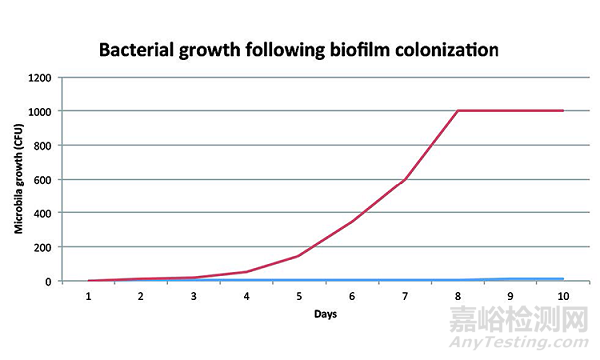您當前的位置:檢測資訊 > 科研開發(fā)
嘉峪檢測網(wǎng) 2021-08-09 21:05
MICROBIOLOGICAL CONCERNS 微生物問題
Potable water from private water companies ormunicipalities is monitored to ensure that levels of chemical pollutants remainwithin established safety criteria, and screened for microorganisms includingEscherichia coli, enterococci,Pseudomonas aeruginosa, and fecal coliforms.4In most locales the quality of the water supplied to thepharmaceutical facility is satisfactory. As a safeguard, however, manyfacilities elect to test the water for organisms like E. coli as a marker forfecal contamination. Onsite potable water is treated, softened, purified(according to the grade required), and distributed.
對私營水務公司或市政當局的飲用水進行監(jiān)測,以確保化學污染物水平保持在既定的安全標準范圍內(nèi),并篩查微生物,包括大腸桿菌、腸球菌、銅綠假單胞菌和糞便大腸菌群。在大多數(shù)地區(qū),提供給制藥工廠的水質(zhì)都還是合格的。然而,作為一項保護措施,許多設施選擇檢測大腸桿菌等生物體,作為糞便污染的標志。現(xiàn)場飲用水經(jīng)過處理、軟化、純化(根據(jù)要求等級)和分配。
While most well-designed water systems can be maintainedin a state of control, microbiological problems can develop. Microbialadherence is a consequence of the balance of attractive and repulsivephysicochemical interactions between bacteria the surface. The primary issue isbiofilm formation—slime-like microbiologicalcommunities that occur when microorganisms adhere to a surface (such aspipework with a poor flow rate).
雖然大多數(shù)設計良好的水系統(tǒng)可以保持在控制狀態(tài),但微生物問題可能會發(fā)生。微生物附著是細菌表面吸附性和排斥性物理化學相互作用平衡的結果。主要問題是生物膜的形成——當微生物粘附在表面時(如流速差的管道),就會發(fā)生粘液樣的微生物群落。
A biofilm develops because bacterial cells, onceattached, secrete a polysaccharide known as glycocalyx (hydrated polymericslimy matrices). The glycocalyx enables each bacterium to encapsulate itself onthe surface; biofilm forms as these organisms accumulate. The steps involved inbiofilm formation are (Figure 1):
生物膜的形成是因為細菌細胞,一旦附著,會分泌一種稱為糖被膜的多糖(水合聚合物粘稠基質(zhì))。糖被膜將每個細菌能夠包裹;隨著這些生物累計,形成生物膜。生物膜形成所涉及的步驟是(圖1):
1. Individual cells populate thesurface (initial attachment)單個細胞在表面附著(初始附著)
2. Irreversible attachment不可脫落的粘附
3. Extrapolymeric substances areproduced and attachment becomes產(chǎn)生聚合物外物質(zhì)
4. Irreversible不可逆轉(zhuǎn)
5. Biofilm architecture develops andmatures生物膜結構形成并成熟
6. Single cells (or clumps of cells)are released from the biofilm over time單個菌(或菌團)隨著時間的推移從生物膜中釋放出來
* Adenosine triphosphate (ATP) is a nucleotide found inall living organisms; ATP bioluminescence is used to monitor contamination.
•三磷酸腺苷(ATP)是所有生物體內(nèi)的一種核苷酸;ATP 熒光檢測可用于監(jiān)測污染。
Figure 1: Generalized biofilm formation
圖1:生物膜形成

Source: D. Davis (CC BY 2.5 [http://creativecommons.org/licenses/by/2.5]), via Wikimedia Commons -footer
This type of attachment occurs relatively slowly. Variousfactors affect the process, including the type of bacterium involved, the sizeof the bacterial population in the environment, and the duration of its growthphase.5 In general, Gram-negative bacteria form biofilmsmore readily,6 due in part to appendages on the bacterial cell(fimbriae) that allow such them to attach to surfaces more easily. Surfacecharge is another important phenomenon in relation to bacterial adherence.7
這種類型的附著發(fā)生得相對較慢。影響這一過程的各種因素,包括所涉及的細菌類型、環(huán)境中細菌數(shù)量及其生長階段的持續(xù)時間。表面電荷是細菌粘附性的另一個重要現(xiàn)象。
Microbial growth in a biofilm is often rapid at the pointof source (Figure 2). The pattern from user outlines is often sporadic,however, because contamination is eluted from the biofilm at different ratesover time.
生物膜中的微生物生長在源頭處通常是很快的(圖2)。然而,用戶大體上的樣本通常是零星的,因為隨著時間的推移,生物膜的污染以不同的速率脫落。
Figure 2: Microbial numbers in a water system riseexponentially following biofilm formation
圖2:水系統(tǒng)中的微生物數(shù)量在生物膜形成后呈指數(shù)級增長

Biofilms are of particular concern with water systems,since Gram-negative bacteria constitute the majority of the bacterialpopulations found in aquatic environments. These types of organisms, moreover,also shed endotoxins, a component of the cell wall.8
水系統(tǒng)特別關注生物膜,因為革蘭氏陰性菌占水生環(huán)境中細菌群的大多數(shù)。此外,這些類型的生物也會釋放內(nèi)毒素——其細胞壁的組成部分。
Many stages of the water-purification process can createconditions which, although designed to reduce contaminants, paradoxicallypromote biofilm formation. An example is in-depth filtration through a matrix.As water percolates through the filter, microorganisms are adsorbed onto thematrix, where they form complex communities. Further on, the purificationpathway can create a series of colonizable environmental niches of varyingnutrient richness.
制水過程的許多階段,雖然設計目的為減少污染,但矛盾地為生物膜的形成創(chuàng)造了條件。一個例子是,通過基質(zhì)進行深過濾。當水通過過濾器滲透時,微生物被吸附在基質(zhì)上,形成復雜的群落。此外,純化路徑也會創(chuàng)造一系列不同營養(yǎng)豐富的繁殖環(huán)境。
For appropriately designed and maintained systems,purified water and WFI present low risks of microbial contamination. Whenevermicroorganisms are detected (and certainly when above specification), however,this creates a significant hazard.
對于設計和維護適當?shù)南到y(tǒng),純化水和WFI具有低微生物污染風險。然而,每當檢測到微生物(超過標準時),就會產(chǎn)生重大危害。
GOOD DESIGN PRINCIPLES 良好設計原則
While different phases of water generation can contributeto risks, there are a number of design and control steps that can reducemicrobiological proliferation:10
雖然制水的不同階段都可以造成風險,但有許多設計和控制步驟可以減少微生物的繁殖:10
Break tanks 阻隔罐
Break tanks, which prevent water produced duringproduction from reentering the water supply, are the first areas in whichmicrobial colonization can occur. Microorganisms present in incoming potablewater attach themselves to the sides and bottom of the tank, forming a biofilm.Samples taken from the tank usually meet the specification for potable waterand give no immediate indication of the biomass that is accumulating. Regularmaintenance and tank flushing are the main preventive measures.
阻隔罐是微生物繁殖的最初可能發(fā)生的地方,它阻止生產(chǎn)期間產(chǎn)生的水重新進入供水系統(tǒng)。流入的飲用水中的微生物附著在水罐的側(cè)面和底部,形成生物膜。從罐中采集的樣品通常符合飲用水的標準,并且不會立即反映正在積累的生物量。主要預防措施是定期維護和沖洗。
Activated carbon beds 活性炭吸附床
The bed matrix consists of finely dividedcharcoal, which is highly efficient at removing low-molecular-weightorganic materials. It also oxidizes and removes additives such as chlorine. Thevast surface area and accumulation of nutrients on the bed, combined withchlorine removal, can lead to rapid microorganism colonization andproliferation. Most of the organisms are Gram-negative bacteria and, shouldthey undergo cell lysis, can be a source of endotoxins. An essential point ofcontrol over the entire water system is the ability to sanitize the bedsregularly with hot water or steam, coupled with frequent replacement.Sanitization should begin at a higher frequency (such as weekly) for a newwater system; this could be decreased over time (monthly) based on a microbialbioburden trend review. Six months to one year of data would be required toassess the bioburden pattern.
吸附床基質(zhì)由細炭組成,在去除低分子量有機物方面效率很高。它還可以氧化和去除添加劑,如氯。床的大表面積和營養(yǎng)物質(zhì)的積累,加上氯的去除,可導致微生物在此迅速繁殖。大多數(shù)生物是革蘭陰性細菌,如果它們經(jīng)歷細胞裂解,可能是內(nèi)毒素的來源。對整個水系統(tǒng)的一個基本控制點是能夠定期用熱水或蒸汽消毒活性炭床,同時經(jīng)常更換。新供水系統(tǒng)的消毒頻率應更高(如每周);根據(jù)微生物負荷的趨勢進行審查,隨著時間的推移(每月)可以減少。評估生物負荷模式需要6個月至1年的數(shù)據(jù)。
Water softeners 水軟化劑
In areas with hard water, softeners are required toprevent interference with the deionizers and reverse osmosis systems. As waterpasses through the resin-filled columns, divalent calcium and magnesium cationsare exchanged for sodium ions. The resin matrix provides an enormous surfacearea for potential microbial colonization, however. Sanitization and controlmeasures such as ultraviolet light and chlorine are essential in maintainingwater quality.
在有硬水的地區(qū),需要軟化劑,以防止對去離子和反滲透系統(tǒng)的干擾。當水通過充滿樹脂的柱子時,二價鈣和鎂陽離子被交換為鈉離子。然而,樹脂基質(zhì)為潛在的微生物微生物提供了巨大的表面積。紫外線和氯等消毒和控制措施對于維持水質(zhì)至關重要。
Deionization devices 去離子裝置
Standard deionization systems consist of charged resincolumns. These may be separate for cation and anion removal, or may use amixed-bed system. The advantage of deionization is that the columns requireregeneration with 1 molarity (M) hydrochloric acid and 1M sodiumhydroxide, both of which are strongly biocidal. If the regeneration frequencyis high, the columns are maintained in a sanitized state. Unsanitized columnsor those that are not regenerated for more than a couple of days present thesame problems as activated charcoal beds, which is the risk of bacterial growthoccurring.
標準去離子系統(tǒng)由帶電樹脂柱組成。可分別用于陽離子和陰離子去除,或者使用混合床系統(tǒng)。去離子的優(yōu)點是,這些柱可以用1摩爾(M)鹽酸和1摩爾(M)氫氧化鈉再生,這兩者都有強殺滅性。如果再生頻率較高,則該柱將保持在已消毒狀態(tài)。未消毒的柱子或那些幾天以上未再生的柱子與活性炭床存在同樣的問題,即細菌生長的風險。
Electrodeionization systems permit continuous columnregeneration without the need to add regeneration agents. They are easy tomaintain, but they also encourage bacterial growth. A reverse osmosis membranewill filter out bacteria, but growth can occur if not properly maintained. Asfragments of the bacterial cell wall break off, endotoxins can easily pass throughthe membrane.
電去離子系統(tǒng)允許連續(xù)的柱再生,而無需添加再生劑。它們易于維護,但同時也促進細菌生長。反滲透膜可以過濾掉細菌,但如果維護不當,就會發(fā)生生長。當細菌細胞壁的碎片脫落時,內(nèi)毒素很容易通過反滲透膜。
Storage and distribution systems 儲存和分配系統(tǒng)
Poorly designed storage and distribution systems createopportunities for recolonization and, ultimately, product contamination.Colonization is often difficult to detect because biofilms releasecontamination slowly and randomly. (Microbial populations in water rarelyindicate normal distribution, which means levels can appear and disappear overtime before the overall trend can be discerned.)
設計不佳的儲存和分配系統(tǒng)為二次繁殖并最終造成產(chǎn)品污染創(chuàng)造了機會。由于生物膜緩慢而隨機地釋放污染,因此很難檢測。(水中的微生物菌落很少呈正態(tài)分布,這意味著在能夠判斷總體趨勢之前,微生物可能會隨時出現(xiàn)并消失。
Storage tanks 儲罐
Water storage tanks are normally constructed fromstainless steel. Where they are used, it is important to determine capacity,rate of use, and frequency of flushing and sanitizing the internal surfaces.Regular water turnover helps prevent contamination; slow turnover, on the otherhand, presents a greater potential contamination risk. Storage tanks should bevented to manage water level fluctuations. To prevent microbial contaminationfrom outside air, vents should be fitted with a hydrophobic air filter. Suchfilters are also used to avoid filter occlusion, which can create vacuumconditions and lead to tank implosion. Vent filter integrity testing should beperformed regularly (e.g., once every 6 or 12 months).
儲罐通常由不銹鋼制成。在使用時,確定內(nèi)部表面的容量、使用率和清洗和消毒頻率非常重要。保持水翻滾有助于防止污染;相反,翻滾速度慢則帶來更大的潛在污染風險。儲罐應通氣以管理水位波動。為了防止來自外部空氣的微生物污染,通氣口應安裝疏水空氣過濾器。此類過濾器還用于避免過濾器堵塞,從而造成真空條件并導致罐體內(nèi)爆。呼吸過濾器完整性測試應定期執(zhí)行(例如,每 6 個月或 12 個月一次)。
Storage temperature 儲存溫度
It is standard practice to store WFI in a recirculatingstainless steel system, although on occasions polyvinylidene fluoride (PVDF) isused when very low mineral content water is needed. Recirculating systems thatoperate at temperatures of 65ºC to 80ºC are self-sanitizing, with the caveatthat no cold spots below 65ºC form. Purified water systems can be hot or cold.Key aspects of cold water systems are discussed in more detail below.
將 WFI 儲存在循環(huán)不銹鋼系統(tǒng)中是標準做法,盡管有時在對水要求極低礦物質(zhì)含量時,會使用聚氯乙烯氟化物(PVDF)材質(zhì)。在65℃至80℃溫度下運行的循環(huán)系統(tǒng)可以自行消毒,需要注意的是,應沒有低于65℃的冷點。純化水系統(tǒng)可以熱或冷循環(huán)。下文將更詳細地討論冷水系統(tǒng)的關鍵方面。
Pipe and tank design 管道和罐設計
If they are poorly designed or improperly maintained,pipes and tanks are more likely than any other part of the water system todevelop contamination. The general requirements for well-designed pipes are:
如果管道和罐設計不當或維護不當,則管道和罐比水系統(tǒng)的任何其他部分都更有可能產(chǎn)生污染。設計良好的管道的一般要求是:
1. Smooth internal surfaces.Microorganisms adhere less well to smooth surfaces than to rough surfaces,therefore corrosion resistance and avoiding rouging (iron oxide formation) isimportant (as can be achieved by the electropolishing of stainless steel). Pipejoints and welds can also disrupt smoothness.
內(nèi)表面平滑。微生物在光滑表面的粘附性不如粗糙表面,因此耐腐蝕和避免紅銹(氧化鐵形成)很重要(通過不銹鋼電拋光可以實現(xiàn))。管道接頭和焊縫也會破壞平滑度。
2. Continuous water movement in tanksand rapid flow in pipework; velocities in the range of 1–2 meters per secondhave been found to be satisfactory.11This minimizesopportunities for microorganisms to adhere to surfaces (and form biofilms).Where shear forces occur, microorganisms adhere poorly to surfaces. Where thereis no water movement, there is no shear (shear increases with the speed offlow).
罐中的水持續(xù)流動,管道中則快速流動;流速在每秒1~2米的范圍內(nèi)可令人滿意。這將最大限度地減少了微生物粘附到表面(并形成生物膜)的機會。在剪切力下,微生物很難粘附在表面上。如水靜止不動,則沒有剪切力(剪切力隨流速而增加)。
Avoid areas where water canremain stagnant:
3. 避免水可能保持停滯的地方:
3.1. If a branch pipe is too long toallow the turbulence of the flowing main to disturb itscontents, water may stagnate in “dead legs” (Figure 3). The principle is toalways minimize the length of branch pipes.
如果支管太長,主管上的湍流無法擾動支管,水可能會停滯在"死腳"中(圖3)。原則盡量減少支管的長度。
3.2. Water can also remain stagnant invalves, particularly at user points—and especially those that not in frequentand regular use. This can be counteracted by hygienic or “zero dead leg” valveswhich, although significantly better than the alternatives (say ball valves).This should not lead to a sense of false security, however, since they canharbor endotoxin-shedding biofilms. Having the correct sloping for drainage canalso reduce contamination risk.
水也可能在閥門中保持停滯狀態(tài),尤其是在用水點,尤其是那些不頻繁和不經(jīng)常使用的閥門。這可以通過衛(wèi)生或"零死腳"閥門來抵消,比其他閥門(如球閥)要好得多。死腳的存在將導致可以脫落內(nèi)毒素的生物膜。正確傾斜排水也可以降低污染風險。
3.3. Ring mains should be sloped(“drop”) from point of origin to the point of return to ensure that systems arecompletely drainable.
循環(huán)管路應從起點到回路傾斜("下降"),以確保系統(tǒng)完全可排空。
4. Avoidance of leakage. Waterleaks can cause bridging of water to the external environment through whichbacteria may enter the system. Storage tanks should be equipped with filter ontheir air vents to prevent air-borne microbiological ingress. They may even beheld under a “blanket” of an inert gas such as nitrogen.
避免泄漏。水泄漏可能導致水與外部環(huán)境接觸,細菌可通過外部環(huán)境進入系統(tǒng)。儲罐應在其通氣口上配備過濾器,以防止空氣傳播微生物進入。它們甚至可以用惰性氣體(如氮氣)"包裹"。
5. High temperature storage anddistribution. The risks of endotoxin-shedding biofilms despite the bestattempts at control above are thought to be so consequential that the mostmanufacturers require the temperature of storage and distribution to bemaintained higher than 65°C. Lower temperatures may also be acceptable,provided the manufacturer has adequate data to demonstrate that a lowertemperature works as intended.
高溫儲存和分配。盡管對上述控制進行最佳嘗試,但內(nèi)毒素脫落生物膜的風險被認為具有如此重大的影響,以至于大多數(shù)制造商要求儲存和分配溫度保持在65°C以上。如果制造商有足夠的數(shù)據(jù)來證明較低的溫度工作正常,則較低的溫度也可以接受。
5.1. It should however be consideredthat 65°C is too high a temperature for most pharmaceutical formulationpurposes. This means that user points are generally equipped with some form ofcooling mechanism. It should be noted that heat exchangers used for thispurpose may be a source of endotoxin and bacterial contamination and may thuscancel out many of the benefits of high temperature circulation.
然而,應該認為,對于大多數(shù)藥物制劑而言,65℃的溫度過高。這意味著用戶點通常配備某種形式的冷卻機制。需要注意的是,用于此目的的熱交換器可能是內(nèi)毒素和細菌污染的來源,因此可能會抵消高溫循環(huán)的許多好處。
6. The use of coated surfaces on pipesand in tanks, where appropriate (as not to pose a risk of leaching toxicsubstances) can help to address bio-fouling.12
在管道和儲罐中使用涂層表面(如不構成釋放有毒物質(zhì)的風險)有助于解決生物污染問題。
Figure 3: Poorly designed water distribution pipe with a dead leg
圖3:設計不良的輸水管道,死腳


來源:GMP辦公室


